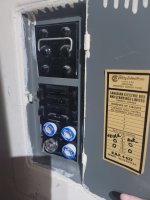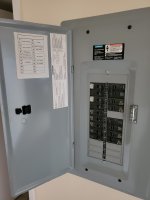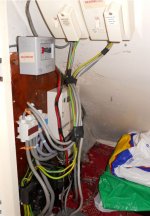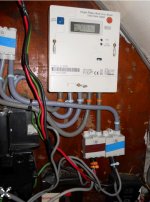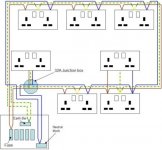A few years ago our mains supply voltage went down to 100v ish, next door were going to buy a new shower but knowing a bit about elektrickery I told them not to bother and rang the lekky company.
A big armoured cable had blown in the supply to our houses, the lads gave me the cable afterwards, the cable was under a section of tarmac carpark where a big puddle sat. Being in rural UK the rain effects our broadband, fone reception and whathaveyou. Recently it's rained for weeks here in the UK ,the ground is saturated, a possible cause of your issue.
First though check the screw terminals on your consumer unit, especially where the big cables come into your house. I've found faults on our and several neighbours consumer units over the years where the terminals to RCB's and ring mains etc were loose. Yours sounds like a possible loose earth connection, neutral is tied to earth on most UK systems. Carefull though, you'll be working on a live system, use properly insulated tools and use your nous.
Andy.
A big armoured cable had blown in the supply to our houses, the lads gave me the cable afterwards, the cable was under a section of tarmac carpark where a big puddle sat. Being in rural UK the rain effects our broadband, fone reception and whathaveyou. Recently it's rained for weeks here in the UK ,the ground is saturated, a possible cause of your issue.
First though check the screw terminals on your consumer unit, especially where the big cables come into your house. I've found faults on our and several neighbours consumer units over the years where the terminals to RCB's and ring mains etc were loose. Yours sounds like a possible loose earth connection, neutral is tied to earth on most UK systems. Carefull though, you'll be working on a live system, use properly insulated tools and use your nous.
Andy.
Last edited:
Wow... That "consumer unit" is very different than whet we get in Canada...
My apartment was built in the 1970s and I still have a "fuse box".
An apart-hotel I stayed in had a more modern "breaker panel".
Of course, we don't use a ring topology here, either.
As far as the OP tightening screws at the main connection to the "consumer unit", I'd leave that to a certified electrician. It's one thing to get 240V or even 480V shock DC from a tube amp, it's another to possibly cause a 480V (or whatever your higher voltage is) arc flash with current behind it. Not that you have 3PH coming into your place, but this is what a 480V arc flash looks like: 480 volt 3 phase Arc Flash Demonstration - YouTube
Koda
My apartment was built in the 1970s and I still have a "fuse box".
An apart-hotel I stayed in had a more modern "breaker panel".
Of course, we don't use a ring topology here, either.
As far as the OP tightening screws at the main connection to the "consumer unit", I'd leave that to a certified electrician. It's one thing to get 240V or even 480V shock DC from a tube amp, it's another to possibly cause a 480V (or whatever your higher voltage is) arc flash with current behind it. Not that you have 3PH coming into your place, but this is what a 480V arc flash looks like: 480 volt 3 phase Arc Flash Demonstration - YouTube
Koda
Attachments
Last edited:
In Britain "a ring main " consumer electrical supply is standard .
Off of each ring main a spur can be taken .
High current appliances like an electric cooker have a separate high current ring main .
Its a popular misconception that "DC" is less dangerous than AC --to the heart --yes ( if you let it travel across your chest ) but DC has a continuous "clamping effect " making it harder to let go .
I have survived only by my thick skin presenting a high resistance to the current path.
Those of my era will remember those big pentodes inside a cage in old tube CRT TV,s , the top cap could be 800 volts (or more ) but the current is high that was the worst shock I had -muscles in right arm throbbed for days -
Dangers of Electric shocks : AC and DC - Electrical Energy in the Home
Off of each ring main a spur can be taken .
High current appliances like an electric cooker have a separate high current ring main .
Its a popular misconception that "DC" is less dangerous than AC --to the heart --yes ( if you let it travel across your chest ) but DC has a continuous "clamping effect " making it harder to let go .
I have survived only by my thick skin presenting a high resistance to the current path.
Those of my era will remember those big pentodes inside a cage in old tube CRT TV,s , the top cap could be 800 volts (or more ) but the current is high that was the worst shock I had -muscles in right arm throbbed for days -
Dangers of Electric shocks : AC and DC - Electrical Energy in the Home
300VDC from left hand to right hand caused a big muscle contraction but I had control of other muscles so I used my knee to push myself away. 120VAC is much harder to let go of in my experience.
A friend of mine who's an electrician actually had to body check a co-worker to stop an AC shock (Only a moron works on 347/600 live, right?)
I had a friend years ago installing a dryer outlet. His brother turned on the power while he was doing it. He woke up 10 minutes later clear across the room.
A friend of mine who's an electrician actually had to body check a co-worker to stop an AC shock (Only a moron works on 347/600 live, right?)
I had a friend years ago installing a dryer outlet. His brother turned on the power while he was doing it. He woke up 10 minutes later clear across the room.
I found out that most untrained people does not know the purpose of the removable insulation cap located on the multimeter test lead tip and remove it permanently, or they use the leads with long metal tips that came with cheap import multimeters. If the naked metal tip slips and creates a short on a high current circuit, ALL the exposed metal will vanish completely in a plasma fireball. To work safely, a test lead with guards such as Fluke TL175 is needed.
This is a more typical install in a house in Canada. The feeders must come through conduit but the branch circuits don't have to be. We don't have rings, ours is like hub and spoke. It's also a before photo 🙂

Then there's always the OCD electrician. Where do you find the time!


Then there's always the OCD electrician. Where do you find the time!

Last edited:
Here each circuit is a "branch" circuit with it's own breaker or fuse (not for new installs). Ground also travels to each box/device. Neutral is tied to ground at the main service panel, nowhere else.


Interesting. I could imagine the current adding up on those first wire runs although I don't know what your socket limits are. In the UK it is 13A per outlet where a double, triple or even quad socket still only counts as one outlet @13A total loading.
In the example above, the entire electrical load will be on a single 15A breaker. Modern code is requiring more and more circuits. My last apartment was build in the early 1950s and the entire place ran on 3 15A circuits not counting the stove. This 1970s apartment is half the size, and has 8 15A circuits not including the stove. In theory, it's a 100A service fed by #4 copper or #2 alu. When I move, they will replace the fuse panel with breakers and a usage meter (it's included in my rent, but not for the next person).
Generally, it's a 15A breaker these days... per branch. #14 copper wire / #12 aluminium (obsolete except for distribution)
Kitchens get split feed (top and bottom are on separate fuses) and it's more common now to have 20A for a kitchen receptacle running #12 copper wire in most places (75c or #14 where 90c is ok). Generally, things are derated to 80% of that. You might get a hair dryer rated for 1875W, but a space heater (electric fire I think you call them) would only be 1500W because it might run continuously, where a hair dryer is short term.
The electric stove will be a double breaker running 240V @ 30A usually. Roughly the same for a dryer. A water heater (electric shower?) usually runs 240V 20A. A spa/hot tub with a 6kW heater and 2.5HP pump is running on a dual 60A breaker at my fathers house.
I wish I could get an electric kettle that used 13A at 240V. Mine uses 12.5A @ 120V !
Generally, it's a 15A breaker these days... per branch. #14 copper wire / #12 aluminium (obsolete except for distribution)
Kitchens get split feed (top and bottom are on separate fuses) and it's more common now to have 20A for a kitchen receptacle running #12 copper wire in most places (75c or #14 where 90c is ok). Generally, things are derated to 80% of that. You might get a hair dryer rated for 1875W, but a space heater (electric fire I think you call them) would only be 1500W because it might run continuously, where a hair dryer is short term.
The electric stove will be a double breaker running 240V @ 30A usually. Roughly the same for a dryer. A water heater (electric shower?) usually runs 240V 20A. A spa/hot tub with a 6kW heater and 2.5HP pump is running on a dual 60A breaker at my fathers house.
I wish I could get an electric kettle that used 13A at 240V. Mine uses 12.5A @ 120V !
Last edited:
I'm not well up on the regulations at all but 3kW kettles are common here. In old money you could run a 3 bar (so 3kW) electric fire from a wall outlet.
Things like electric showers are rated between 7kw and 10.5kw with 8.5 and 9.5kW probably the most common. They are on their own feed with their own breaker.
Ring mains are rated at 30 amps I think on the basis that a typical user wouldn't plug a 3kW fire into every socket on the ring main.
The maximum loading I get is...
Two 3.4kW storage heaters and two 2.55kW heaters. Those come on at midnight for 7 hours. It is possible that all four may be active when the 3kW immersion is also on and also when the 3kW kettle is put on and perhaps an additional 2.5kW of extra room heat.
What's that... over 20kW. That is a scenario that happens here and that is getting close to the nominal 100A 24kW limit. You couldn't risk putting the shower on as well. After 7am the four storage heater are disconnected automatically (cheap rate dual tariff meter).
Things like electric showers are rated between 7kw and 10.5kw with 8.5 and 9.5kW probably the most common. They are on their own feed with their own breaker.
Ring mains are rated at 30 amps I think on the basis that a typical user wouldn't plug a 3kW fire into every socket on the ring main.
The maximum loading I get is...
Two 3.4kW storage heaters and two 2.55kW heaters. Those come on at midnight for 7 hours. It is possible that all four may be active when the 3kW immersion is also on and also when the 3kW kettle is put on and perhaps an additional 2.5kW of extra room heat.
What's that... over 20kW. That is a scenario that happens here and that is getting close to the nominal 100A 24kW limit. You couldn't risk putting the shower on as well. After 7am the four storage heater are disconnected automatically (cheap rate dual tariff meter).
Incredible!
Most people use gas for heating the house and the water here since the average electric rate in Toronto is 18 cents / kWh! lowest being like 10 cents, highest peak period like 24 cents.
Example: A 1500 watt load running 24/7/365 would cost almost 2000$ not including the "customer charge" (they print you a bill, $38.34/30 days), the transmission charge of 1.643 cents /kWh, the "debt retirement" charge (government borrowed money to make electricity cheaper in the 80s and 90s... we're still paying it off - EDIT: This ended in 2018, I was unaware of that), the Wholesale Market Service Charge of 0.39 cents /kWh and taxes (13%) etc. There a reason I'm reluctant to move. I would pay about 300$/month extra for electric!
See this for more info on how we get hosed 🙂 Residential electricity rates - Toronto Hydro
Most people use gas for heating the house and the water here since the average electric rate in Toronto is 18 cents / kWh! lowest being like 10 cents, highest peak period like 24 cents.
Example: A 1500 watt load running 24/7/365 would cost almost 2000$ not including the "customer charge" (they print you a bill, $38.34/30 days), the transmission charge of 1.643 cents /kWh, the "debt retirement" charge (government borrowed money to make electricity cheaper in the 80s and 90s... we're still paying it off - EDIT: This ended in 2018, I was unaware of that), the Wholesale Market Service Charge of 0.39 cents /kWh and taxes (13%) etc. There a reason I'm reluctant to move. I would pay about 300$/month extra for electric!
See this for more info on how we get hosed 🙂 Residential electricity rates - Toronto Hydro
Last edited:
It's pretty scary isn't it. Annual consumption I reckon to be around 16 to 18000 units a year with a 70/30 split toward the cheap night rate.
And... that's me done for tonight 😉
And... that's me done for tonight 😉
electricity here is expensive about £0.13 / kwh
Gas around £0.03 / kwh
and if you buy cords of hardwood from the local coppice (as I do), then dry and process yourself and burn in a woodfired stove about £0.01 / kwh.......but errr..not including labour!!
Well an interesting day supply day.....
Power cut due to fallen tree and overhead mains cable to ground somewhere near us...back on in the afternoon. Checked the voltage around 225V.
Put some music on, checked the voltage 227V ......four tracks in and bzzzz.woooowooow,pop - hit the mute, out with the DMM 219V.
Also the amp have a brown out auto mute, mine is not auto mute, but still operates a flashing LED to show the amp needs to wait to warm/up stabilise. Guess what it started flashing (normally only activated with first switch on)...So I think that answers my amp stability problem = mains problem.
Now all I have to do is get UK power networks to fess up and solve it....or I am going to have to solve with a variac or similar.
Not very relaxing listening and simultaneously preparing for the sprint for the manual mute switch....
Gas around £0.03 / kwh
and if you buy cords of hardwood from the local coppice (as I do), then dry and process yourself and burn in a woodfired stove about £0.01 / kwh.......but errr..not including labour!!
Well an interesting day supply day.....
Power cut due to fallen tree and overhead mains cable to ground somewhere near us...back on in the afternoon. Checked the voltage around 225V.
Put some music on, checked the voltage 227V ......four tracks in and bzzzz.woooowooow,pop - hit the mute, out with the DMM 219V.
Also the amp have a brown out auto mute, mine is not auto mute, but still operates a flashing LED to show the amp needs to wait to warm/up stabilise. Guess what it started flashing (normally only activated with first switch on)...So I think that answers my amp stability problem = mains problem.
Now all I have to do is get UK power networks to fess up and solve it....or I am going to have to solve with a variac or similar.
Not very relaxing listening and simultaneously preparing for the sprint for the manual mute switch....
UK Power Networks is a power distributor for your general area Tonescount --they are NOT the power generator .
According to company records the previous name was EDF Energy they are the power generators --a wholly owned French State company -
Electricite de France
but that is not the end of the story the actual French generator equipment including the patents owned by Alstom ( French generator plus other interests ) was bought by US giant GE- General Electric in November -2015.
According to company records the previous name was EDF Energy they are the power generators --a wholly owned French State company -
Electricite de France
but that is not the end of the story the actual French generator equipment including the patents owned by Alstom ( French generator plus other interests ) was bought by US giant GE- General Electric in November -2015.
Many of the houses in Sweden have 3 phase supplies, something historical to do with running motors, but also to cater for electric heating. The advantage is that most wires carry no more than 10 amps, so no need to deal with 6mm2 solid core cables.
I used to think the UK system with a ring was safest, but actually it is designed to minimise the risk of fire, whereas multiple (20 or more) circuits with a max of 10 or 6 amps, on RCDs are more about compartmentalising and safety.
I used to think the UK system with a ring was safest, but actually it is designed to minimise the risk of fire, whereas multiple (20 or more) circuits with a max of 10 or 6 amps, on RCDs are more about compartmentalising and safety.
Last edited:
kodabmx said:Wow... That "consumer unit" is very different than what we get in Canada...
...I still have a "fuse box".
...a more modern "breaker panel".
...Of course, we don't use a ring topology here, either.
Generally, it's a 15A breaker these days... per branch.
--
...they will replace the fuse panel with breakers and a usage meter (it's included in my rent, but not for the next person).
... I'm reluctant to move. I would pay about 300$/month extra for electric!
Wow! One stove four lights! Penny-boxes! And is the glass fuse reserved for a penny? (The others look like penny-proof replacements; try a dime.) That's like my first house; built 1948 bought 1981. That is still legal here but the insurance companies often demand replacement with breaker-box.
Obviously there are two markets. US/Canada still use heavy steel with busbars and proprietary breakers. I'm not sure of the history of the Euro/DIN scheme but it is standard in most of Europe. Most of the rest of the world follows one or the other system depending where they got dynamos in 1899.
Nearly all 120V circuits in US are wired 20A and #12. The move away from #14/15A started in the 1970s when two 20A kitchen/pantry circuits were required, then 20A laundry.
AFAIK, *only* England and some of her ex-colonies use Ring Main in small buildings. Was a proposal for post-WWII rebuilding which got adopted. It is debatable in terms of saving precious (post-WWII) copper. To really save money it needs individual fusing at each point. When a fuse was a replaceable wire this was a small expense, but begs for oversize fusewire and then linecord fire. There's nothing wrong with Ring Main, but not "better" overall for most domestic work. (Ring Main is applied to factory campuses in the US, where very large loads are predictably distributed and also the ring may be broken for changes without darkening the whole campus.)
No, you won't pay $300/month for apartment electric. My $/kWH is within sight of yours; actually higher on the exchange rate. Two humans in a fair size stand-alone house in dark woods, electric hot water, spot electric heat, electric stove, I just wrote the check for $133. That's high because xmas lights on TWO garages plus the house since mid-November.
Your last paragraph makes sense PRR , as of 2019 figures natural gas gas accounts for the majority of electrical generation in the USA -43 % .
This has reduced in price .
Courtesy of the US Energy Information Administration.
OTOH UK electricity prices are high - 23(US) cents/kWh.
Average Unit Cost of Electricity in the UK 2021 | NimbleFins
Compare with Russia =7 (US) cents/kWh
USA=(average ) due to different electricity prices in each State =14 cents/kWh -2019 figures.
This has reduced in price .
Courtesy of the US Energy Information Administration.
OTOH UK electricity prices are high - 23(US) cents/kWh.
Average Unit Cost of Electricity in the UK 2021 | NimbleFins
Compare with Russia =7 (US) cents/kWh
USA=(average ) due to different electricity prices in each State =14 cents/kWh -2019 figures.
I paid 250$/month 10 years ago. I have 2 air conditioners, 24/7 tube amps, electric stove, multiple computers, and at one time I was plugging in a block heater. Even if I had electric with the panel turned off, the monthly bill would be more than 50$ just for the privilege of using it if I wanted to. Check the link I posted earlier 🙂
Our bill calculator estimates I'd pay 300$/month based on 1500kWh (without the rebate). I'd be with Toronto Hydro... Bill calculator | Ontario Energy Board
For the record, it would be about what you pay if I lived in Québec instead of Ontario.
How much would you pay in Manhattan, PRR?
Oh, and the 4 P type fuses are for the outlets and lights in the apartment, there are also four 15A cartridge fuses for the kitchen outlets, and the standard larger cartridges for the stove. There is 100A service here and it's only 400 square feet... Since I scrapped off the bus bars and applied Vasoline to the fuse contact, the fuses never blow now (unless you try - plugged in a shorted cord last week - instant blown fuse). They used to start arcing on load which would heat and melt the thermal part of the fuse.
Our bill calculator estimates I'd pay 300$/month based on 1500kWh (without the rebate). I'd be with Toronto Hydro... Bill calculator | Ontario Energy Board
For the record, it would be about what you pay if I lived in Québec instead of Ontario.
How much would you pay in Manhattan, PRR?
Oh, and the 4 P type fuses are for the outlets and lights in the apartment, there are also four 15A cartridge fuses for the kitchen outlets, and the standard larger cartridges for the stove. There is 100A service here and it's only 400 square feet... Since I scrapped off the bus bars and applied Vasoline to the fuse contact, the fuses never blow now (unless you try - plugged in a shorted cord last week - instant blown fuse). They used to start arcing on load which would heat and melt the thermal part of the fuse.
Last edited:
- Home
- Amplifiers
- Tubes / Valves
- know any GOOD repair guys...
